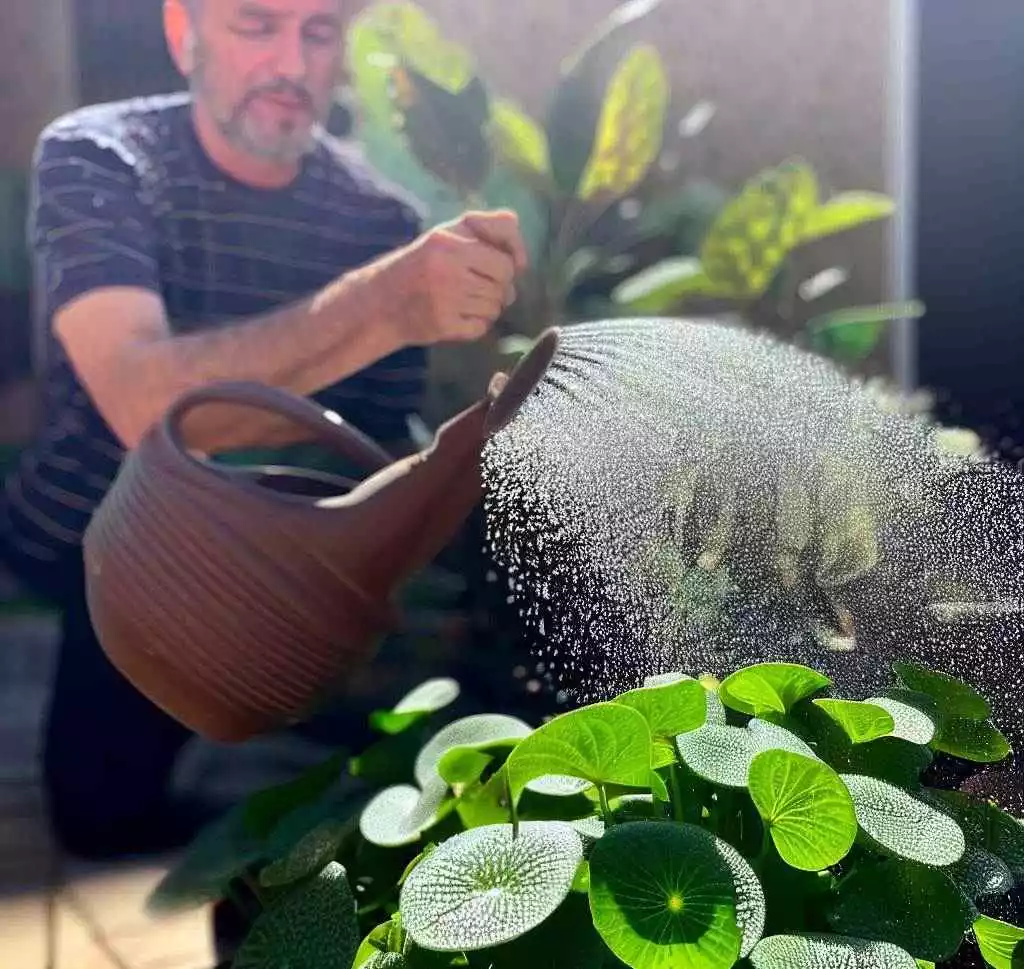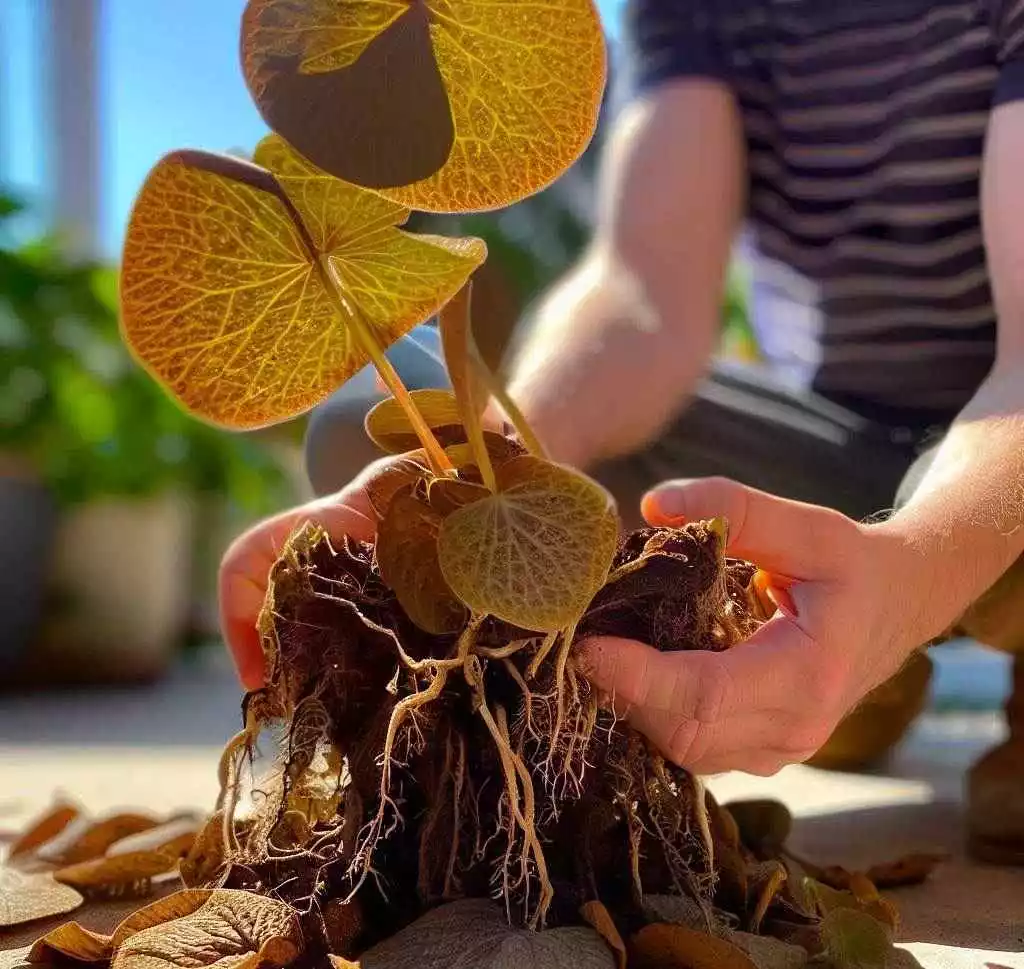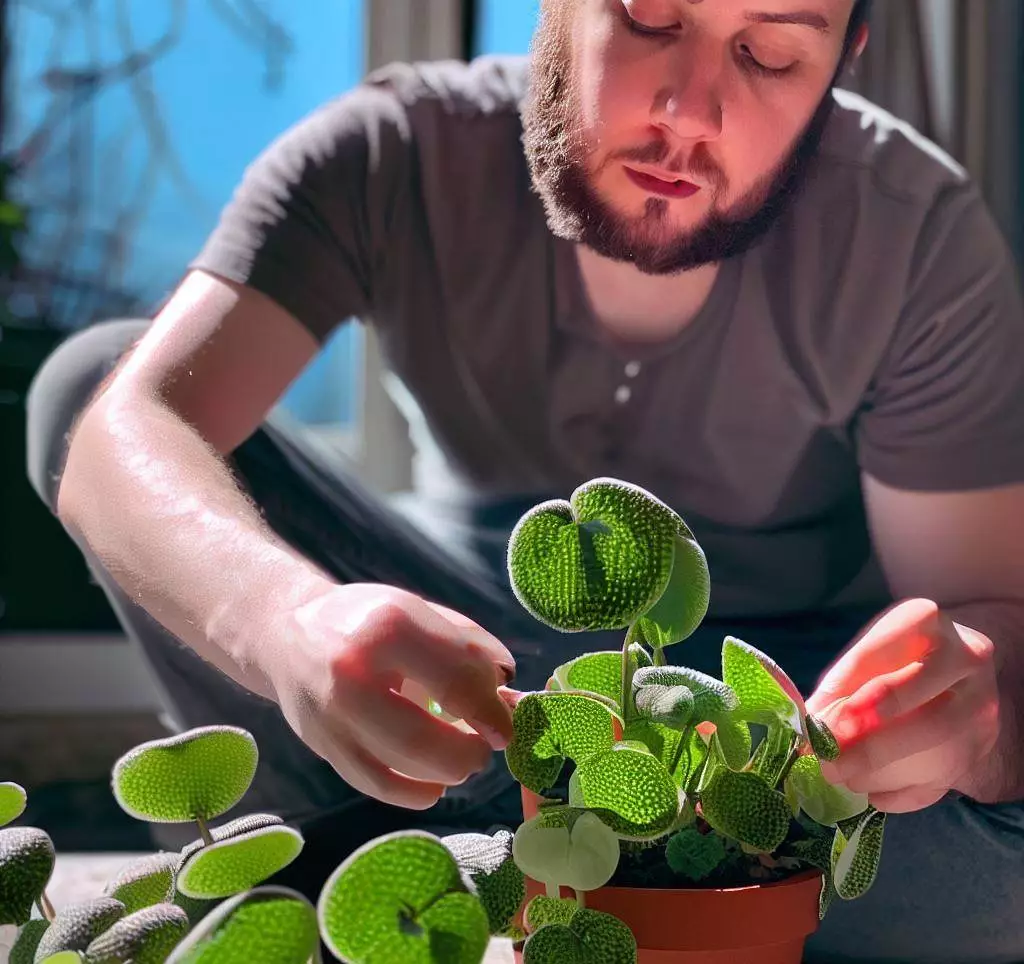If you own a Pilea plant, you may have faced the issue of inward-curling leaves.
It can be distressing to see your previously healthy plant start to look unwell, affecting its appearance and indicating an underlying problem that needs to be resolved to keep your Pilea flourishing.
In this guide on pilea leaves curling inwards, we’ll discuss the five major reasons, and offer practical tips to fix the issue, covering environmental factors, watering problems, nutrient deficiencies, pest infestations, and root rot.

We’ll also address the physical signs of inward-curling leaves and how to prevent the issue from occurring. We understand how discouraging it can be to have your cherished Pilea suffer, so we’ve produced this comprehensive article to help you address the problem.
Keep reading to learn how to restore your plant to a healthy and happy state.
Table of Contents
5 Major Causes of pilea leaves curling inwards
As an owner, you may have noticed the pilea leaves curling inwards, indicating an underlying issue that needs to be resolved.
To help you troubleshoot the problem, we’ll explore the five major causes of inward-curling Pilea leaves, covering environmental factors, watering issues, nutrient deficiencies, pest infestations, and root rot.
Environmental factors
Environmental factors play a significant role in the health of your Pilea plant, with inadequate humidity, temperature, and light levels leading to inward-curling leaves.
- Low humidity levels cause the leaves to curl inward as the plant tries to conserve moisture. Studies have shown that low humidity levels can lead to plant stomatal closure, resulting in reduced gas exchange and increased water loss, causing the plant to curl inward.
- Extreme temperatures, whether too hot or cold, can stress the plant and cause the leaves to curl inward.
- Inadequate light levels can cause the plant to grow abnormally, leading to inward-curling leaves. This is because the plant needs sufficient light to produce chlorophyll and carry out photosynthesis, which helps the plant grow and stay healthy.
Watering issues
Whether overwatering or underwatering, watering issues can cause the leaves to curl inwards.

- Overwatering can lead to root rot, causing the leaves to curl inward and turn yellow. Studies have shown that overwatering can lead to oxygen deprivation in the root zone, creating a favorable environment for root pathogens to thrive and attack the roots.
- On the other hand, underwatering can cause the plant to wilt and the leaves to curl inward as the plant tries to conserve water. The plant needs water to carry out vital processes like photosynthesis, nutrient uptake, and growth.
Nutrient deficiencies
A scarcity of vital nutrients in the soil or disproportionate fertilization can result in Pilea leaves curling inwards. Typical deficiencies affecting Pilea plants include nitrogen, iron, and magnesium, which may lead to leaves turning pale or yellow.
These elements are essential for the healthy growth and development of plants. Nitrogen is a fundamental constituent of chlorophyll, iron is indispensable for photosynthesis, and magnesium is needed for chlorophyll production.
Pest infestation
Insect invasions may lead to Pilea leaves curling inwards, with common culprits like spider mites, mealybugs, and thrips potentially causing significant harm to the plant. Here is how each pest can impact your Pilea leaves:
- Spider mites: These minuscule arachnids feast on the lower side of leaves, resulting in stippling or yellowing of the foliage. Eventually, this may cause the leaves to curl and drop off. Additionally, spider mites create webbing that can envelop the plant, hindering photosynthesis and growth.
- Mealybugs: These soft-bodied insects extract sap from the plant, causing the leaves to curl and turn yellow. They excrete a sticky substance called honeydew, which can draw other pests and promote mold development. Furthermore, mealybugs can transmit diseases to the plant, exacerbating the problem.
- Thrips: These narrow insects consume the surface of leaves, leading to malformations, discoloration, and curling. They can also transmit viruses to the plant, decreasing yield and stunted growth. Thrips are challenging to identify since they are tiny and can conceal themselves in the plant’s crevices.
Root rot
A fungal disease known as root rot can develop due to excessive watering, causing leaves to curl inwards and become yellow. This fungus infiltrates the plant’s roots, leading to decomposition and eventual death.
Scientific investigations reveal that the fungus affects the root cortex, which is responsible for drawing water and nutrients from the soil.

This interference results in diminished nutrient absorption and hinders plant growth. If left untreated, root rot can inflict lasting harm on the plant, as it may lose its ability to effectively take in water and nutrients.
Symptoms of inward curling of Pilea leaves
Symptoms of inward curling of Pilea leaves can vary depending on the underlying cause. Here are some common physical appearances of leaves that may indicate inward curling:
- The physical appearance of leaves: Inward curling of Pilea leaves can be observed visually, with the leaves curling inwards towards the stem. This can give the plant a wilted appearance, making the leaves brittle and fragile. The affected leaves may appear twisted or distorted, with a leathery texture. In severe cases, the leaves may curl downwards, creating a cup-like shape.
- Leaf color changes: The leaves may change color depending on the cause of inward curling. For example, nutrient deficiencies can cause the leaves to turn yellow or pale, while pest infestations can cause discoloration and spotting. The leaves may sometimes develop brown or black edges, indicating stress or damage. Additionally, the veins of the leaves may become more pronounced, indicating a lack of nutrients.
- Stunted growth: Inward curling of Pilea leaves can also lead to stunted growth, as the plant may not be able to absorb nutrients effectively. The plant may appear smaller or weaker than usual, and the leaves may not reach full size. The stem may become thin and spindly, and the plant may not produce as many leaves or flowers as usual.
- Wilting: In severe cases, inward-curling Pilea leaves can lead to wilting of the entire plant. The leaves may dry, and crispy, and the stems may droop or bend downwards. The plant may appear lifeless and unresponsive, and the leaves fall off easily when touched.
How to fix inward curling of Pilea leaves

Adjusting environmental conditions
One way to fix the inward curling of Pilea leaves is to adjust the plant’s environmental conditions. This can involve controlling humidity levels, temperature, and light exposure to ensure the plant thrives. Here are some tips for adjusting the environmental conditions of your Pilea:
- Humidity: Pilea plants prefer a high level of humidity, around 50-60%. You can increase humidity by placing a tray of water near the plant or using a humidifier.
- Temperature: Pilea plants thrive between 65-75°F (18-24°C). Avoid placing your plant near drafts or in areas with fluctuating temperatures.
- Light: Pilea plants prefer bright, indirect sunlight. Too much direct sunlight can cause leaf burn, while too little light can cause the plant to become weak and leggy. You can adjust light exposure by moving the plant to a different location or using a sheer curtain to filter light.
Correcting watering practices (overwatering, underwatering)
To fix the inward curling of Pilea leaves caused by watering practices, it’s important to follow some key guidelines. Here are some additional tips:
- Check for drainage: Make sure your Pilea is planted in a pot with drainage holes. Water can accumulate in the soil without proper drainage, leading to root rot and other issues.
- Consider the season: During winter, Pilea plants require less water due to lower light levels and cooler temperatures. Adjust your watering schedule accordingly to prevent overwatering.
- Use room-temperature water: Cold water can shock the plant and lead to stress. Use room-temperature water when watering your Pilea to avoid any potential issues.
- Monitor humidity levels: Pilea plants prefer moderate to high humidity levels. Consider using a humidifier or placing a water tray near the plant to increase humidity levels.
In addition, consider the type of soil you are using. Pilea plants prefer well-draining soil that allows for air circulation around the roots. A soil mix containing perlite or vermiculite can help improve drainage and prevent overwatering.
Providing proper nutrients
Nutrient deficiencies can cause inward curling of Pilea leaves, so it’s important to ensure that the plant receives the proper nutrients. Here are some tips for providing proper nutrients:
- Soil quality: Ensure that your plant is planted in nutrient-rich soil. You can also use fertilizer to provide additional nutrients.
- Fertilizer: Use a balanced fertilizer that contains nitrogen, phosphorus, and potassium. Fertilize your Pilea monthly during the growing season (spring and summer) and reduce fertilizer during the dormant season (fall and winter).
- Nutrient deficiency treatment: If you suspect a nutrient deficiency, you can treat it with a specific fertilizer designed for that nutrient deficiency.
Treating pest infestations
If pests are causing inward-curling Pilea leaves, it’s important to take immediate action to eliminate them. Here are some steps you can take to treat pest infestations:
- Identify the type of pest: Different pests require different treatments, so it’s important to correctly identify the pest before attempting to treat it. You can use a magnifying glass to closely examine the pest and identify it.
- Remove heavily infested leaves: If many many are heavily infested, removing them from the plant may be best to prevent the infestation from spreading.
- Use insecticidal or neem oil: Incidal and neem oil active, non-toxic treatments for many common plant pests. Follow the instructions on the product label to mix and apply the solution to the affected plant.
- Use sticky traps: Sticky traps can catch flying pests, such as fungus gnats or thrips. Place the traps near the plant to trap any flying pests.
- Introduce natural predators: Some pests have natural predators that can help control their population. For example, ladybugs can help control aphids, while predatory mites can help control spider mites.
- Repeat treatment: Pest treatments may be repeated several times to eliminate the infestation. Monitor the plant closely and continue treatments until the pests are completely gone.
Addressing root rot
If your Pilea has root rot, acting quickly to prevent further damage is important. Here are some steps you can take to address root rot:
- Remove the affected plant from its pot: Carefully remove it from its pot and inspect the roots for signs of rot. Healthy roots should be firm and white, while roots affected by rot will be brown and mushy.
- Trim away affected roots: Trim away any affected roots using a clean pair of scissors or shears. Be sure to cut back to healthy tissue to prevent the rot from spreading further.
- Repot the plant in fresh soil: Choose a new pot with drainage holes and fill it with fresh, well-draining soil. Gently place the plant in the new pot and backfill it with soil, being careful not to cover the stem.
- Adjust watering practices: To prevent future root rot, adjusting your watering practices is important. Allow the soil to dry out slightly between waterings and avoid overwatering.
- Monitor the plant closely: Keep a close eye on the plant after repotting and adjust care as needed. It may take some time for the plant to recover, so be patient and provide proper care.
Pro tips for preventing Pilea leaves Curling Inwards
As the old saying goes, prevention is better than cure. Following some simple pro tips, you can prevent inward curling of Pilea leaves before it becomes an issue.
Here are some pro tips to keep your Pilea plants healthy and happy:

- Regularly inspecting the plant for signs of issues: One of the best ways to prevent inward curling of Pilea leaves is by inspecting the plant regularly for signs of issues. This can include checking the leaves for discoloration or spotting, looking at the soil for signs of overwatering or underwatering, and examining the stems for any damage or signs of disease. By catching issues early on, you can take action before they escalate and affect the plant’s health.
- Maintaining proper environmental conditions: Maintaining proper environmental conditions is also crucial for preventing the inward curling of Pilea leaves. This includes ensuring the plant receives the right amount of light, humidity, and temperature. Pilea plants thrive best when exposed to bright but indirect light. They enjoy temperatures between 60 and 75°F (15-24°C) and high humidity levels. By providing the right environmental conditions, you can prevent stress on the plant that can lead to inward curling of the leaves.
- Watering consistently and appropriately: Consistent and appropriate watering is another key factor in preventing the inward curling of Pilea leaves. As mentioned earlier, Pilea plants prefer evenly moist soil, so make sure to water the plant when the soil feels slightly dry to the touch. Try to do your best to minimize overwatering, as this can and will lead to root rot and other issues. Watering the soil directly and avoiding getting water on the leaves is also important, as this can lead to fungal issues.
- Fertilizing regularly: Providing your Pilea plant with the proper nutrients is essential for preventing inward curling of the leaves. Make sure to fertilize your plant regularly with a balanced fertilizer to ensure it receives the necessary nutrients. Always read the instructions on the fertilizer packaging carefully and follow them for the best results.
- Preventing pests and diseases: Finally, preventing pests and diseases is crucial for keeping your Pilea plant healthy and preventing inward curling of the leaves. Make sure to keep your plant clean and hygienic, and inspect it regularly for signs of pests or diseases. You can also use preventive measures such as neem oil or insecticidal soap to keep pests at bay.
By following these pro tips, you can prevent the inward curling of Pilea leaves and keep your plant healthy and happy. Remember, a little bit of prevention can go a long way in ensuring the health and longevity of your plants.
Frequently Asked Questions (FAQs)
Can underwatering cause inward curling of Pilea leaves?
Yes, underwatering can cause inward curling of Pilea leaves.
What type of lighting does Pilea require?
Pilea requires bright, indirect light.
How often should I fertilize my Pilea?
You should fertilize your Pilea every two weeks during the growing season.
What should I do if my Pilea has root rot?
If your Pilea has root rot, remove any affected roots, repot in fresh soil, and adjust your watering practices.
Conclusion:
Experiencing Pilea leaves curling inwards can be frustrating for any plant owner, but it can be prevented and fixed with the right knowledge and care.
We’ve discussed the major causes, symptoms, and solutions to fix them. Maintaining proper environmental conditions, watering practices, nutrient levels, and pest prevention are key to preventing this issue.
Regularly inspect your plant and address any issues immediately. We hope this guide has been helpful. Read more similar topics on our website and check back soon for more.


